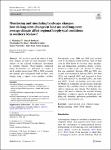Item Infomation
Full metadata record
| DC Field | Value | Language |
|---|---|---|
| dc.contributor.author | Nkolokosa, C. | - |
| dc.contributor.author | Stothard, Russell | - |
| dc.contributor.author | Jones, Christopher M. | - |
| dc.date.accessioned | 2023-10-04T03:25:34Z | - |
| dc.date.available | 2023-10-04T03:25:34Z | - |
| dc.date.issued | 2023 | - |
| dc.identifier.uri | https://link.springer.com/article/10.1007/s10661-023-11783-9 | - |
| dc.identifier.uri | https://dlib.phenikaa-uni.edu.vn/handle/PNK/9443 | - |
| dc.description | CC-BY | vi |
| dc.description.abstract | We set out to reveal the effects of long-term changes in land use and long-term average climate on the regional biophysical environment in southern Malawi. Object-oriented supervised image classification was performed on Landsat 5 and 8 satellite images from 1990 to 2020 to identify and quantify past and present land use-land cover changes using a support vector machine classifier. Subsequently, using 2000 and 2010 land use-land cover in an artificial neural network, land use-land cover for 2020 driven by elevation, slope, precipitation and temperature, population density, poverty, distance to major roads, and distance to villages data was simulated. Between 1990 and 2020, area of land cover increased in built-up (209%), bare land (10%), and cropland (10%) and decreased in forest (30%), herbaceous (4%), shrubland (20%), and water area (20%). Overall, the findings reveal that southern Malawi is dominantly an agro-mosaic landscape shaped by the combined effects of urban and agricultural expansions and climate. | vi |
| dc.language.iso | en | vi |
| dc.publisher | Springer | vi |
| dc.subject | simulating landscape | vi |
| dc.subject | southern Malawi | vi |
| dc.title | Monitoring and simulating landscape changes: how do long-term changes in land use and long-term average climate affect regional biophysical conditions in southern Malawi? | vi |
| dc.type | Book | vi |
| Appears in Collections | ||
| OER - Khoa học môi trường | ||
Files in This Item:

